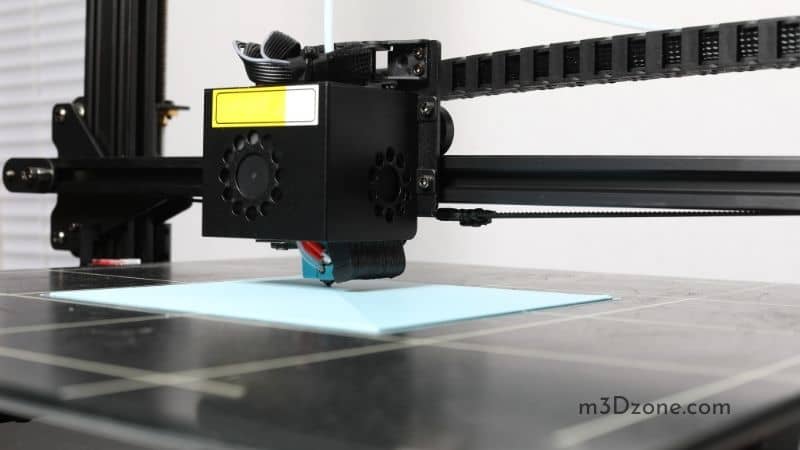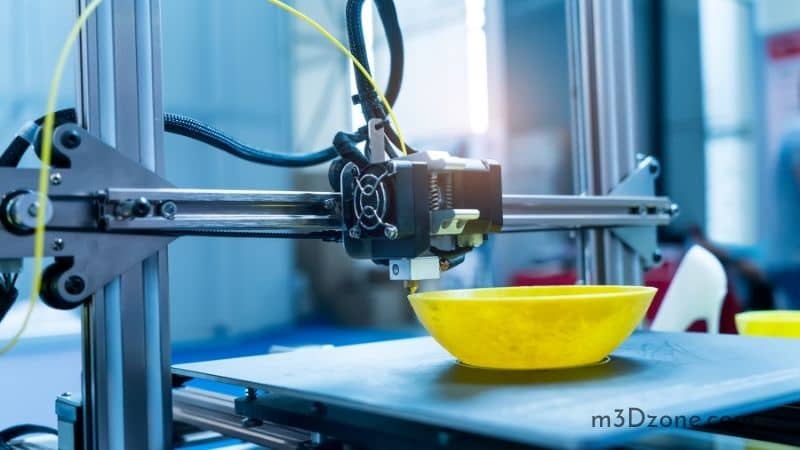This article will help you learn all you need to know about PLA filament and its safety with food and what will happen when you consume it.

As an Amazon Associate, I earn from qualifying purchases. If you make a purchase after clicking on a link I may earn a small commission at no extra cost to you.
PLA is made from corn which makes it safe to use with food. Although when combined with other additives, it can be unsafe to take in.
An example is color. When color is added to the PLA, then it is no longer safe to ingest. Some PLA filaments are designed for food use. When purchasing, ensure you check on the manufacturer’s instructions to ensure it is safe for food use.
Quick Navigation
A plain PLA material can be used to make food packages. When designing it for a food package, ensure what you are packing is not too hot. Also, when using a PLA-made package, it shouldn’t be used for more than two days as it will accumulate bacteria and dirt that are hard to clean.
PLA filament is biodegradable, so you can add it to your compost heap after using it.
Food Safe 3D Printing: Why Is It So Important?
A component is considered food-safe if you can use it directly with the food and not, of course, have any health issue. This involves the smell, taste, and quality which shouldn’t be affected by the material.
What Is a Food-safe Material?
A food-safe material should have the following qualities:
- There should be no harmful migration of harmful materials which are in direct contact with the material.
- The material should not transmit smell, color, or even taste.
- It should be safe under normal conditions.
- Should be durable, non-absorbent, and should resist corrosion.
- The material should be strong in a way it can withstand washing.
- A straight surfaced material that doesn’t have cracks, smooth, and easy to clean is what is preferred in food use materials.
Importance
With a 3D printer, almost everything is printable. But when dealing with food-safe materials, you need to ensure you get them right. This makes it easy with 3D printers as you have many options to choose from.
The material you choose should benefit your health and avoid interfering with the quality of the food.

The material should be biocompatible to ensure it is completely safe for the human body. That way, it ensures your health is not at risk from using bad material.
3D printing is used in different industries and companies. It offers lots of solutions in the production industries. The best part is one can develop impressive designs and customize the products to give them a personal touch.
Related: What Is 3D Printing Used For?
Risks and Solutions
Let’s see what risks are involved and how you can prevent them.
-
Bacterial Building Up
For 3D printed parts, they can get attacked by bacteria in a week when they are in contact with bacteria-infested surfaces. Some of the materials will survive in the dishwasher, but some of the bacteria will too; an example is E. coli and salmonella.
This is because they live in nooks and crannies. There are also toxic molds that find good and favorable growth conditions on some plastic types, and it becomes hard to get rid of them. At that point, cleaning with bleach and microwaving the polymer will not eliminate the germs.
If the materials you are making are disposable, then the build-up issue is not an issue for you. But in a case where the object is for long-term use, consider using a food-safe coat.
-
Food-safe Coat and Sealant
To reduce risks and solve the build-up issue, you have the option of dipping the 3D printed material in a food-grade epoxy or the polyurethane resin; an example is the masterbond’s EP42HT-2FG, ArtReain, FDA that is approved by PTFE. This way, you seal the surfaces making it safe to use.
The coating is not forever guaranteed because some of those food-safe coatings are not dishwasher safe. With time they will degrade, exposing the unsafe surfaces.
-
Dishwasher Safety
Most 3D materials have a low heat deflection temperature (HDT). This means when the 3D materials are exposed to heat, they brittle and crack, or at some point, they will wrap and deform when exposed to elevated temperatures.
Before dishwashing, any parts created through 3D printing, ensure you check for facts whether the parts can be dish-washed and the specific washing temperatures given on the manufacturing.
-
Food Safe Equipment
Particles might migrate from the 3D printer to the 3D printed part; thus, all the materials that come in contact with the printed part are food safe and don’t contain any harmful substance or affect food taste.
When you are using multiple materials, check the materials you had used previously as they may contain toxic particles that can cause harm.
-
Food Safe 3D Printing Material
Most 3D printing materials are not food safe. They contain toxic chemicals that can cause harm to the human body. Ensure the materials you use are safe and certified as being food safe.
-
Food Contact Time
The less time the food is in contact with the 3D printed parts, the better. That ensures the food is only exposed for short periods of time. You can also take other precautions like wrapping the food with food-safe materials and then placing it on the 3D printed part.
Is PLA Filament Food Safe?
PLA, which is polylactic acid, is a bioplastic material. PLA 3D printing filaments are from natural materials like corn, tapioca, and potatoes. It is made from lactic acid in natural materials.
Lactic acid is an organic acid that is involved in our daily life. When you feel sour on your muscles after a workout, that is a result of lactic acid. Sour milk is also a source of lactic acid.
Lactic acid is from converting glucose to lactic acid. Corn is considered a source of glucose, which is why it is issued in PLA materials production. With that knowledge, you can clearly and confidently say PLA is safe as it comes from things taken by humans.
PLA, just like ABS, is used in making many objects from food containers, garbage bags, and disposable tableware. Making food containers using 3D printing and the PLA material is not ideal.
The 3D printers leave gaps and cavities on the object to a point it can’t conceal moisture. After washing a few times, the objects develop molds that are impossible to get rid of.
You might like: 3D Printing vs Injection Molding
The PLA used in 3D printing is biodegradable and, at the same time, more durable than other thermoplastics, an example ABS. Also, its lower tensile strength property makes it more brittle.
PLA is food safe if it contains the following properties:
- The object created is smooth
- The PLA filament is used alone with no other additives
- The nozzle used in printing is stainless steel
- The nozzle also should be clean
- Do not wash any object made from PLA using the dishwasher
- Keep coating the object regularly with epoxy resin to make the object food safe
Is PLA Bad for Health?
Plastic PLA filament (see the price on Amazon) material used in 3D printing processes, on its own with no additive does not raise food safety and health concerns as it is from lactic acid, which comes from glucose which comes from objects that humans consume.
When it comes to the emission of ultrafine particles and volatile organic compounds from 3D printing using multiple filaments, the PLA is the least harmful to human health. Most of what it emits is lactide which is low on the harm scale.
Although every person is different, one person can be affected by one substance than the other. Also, PLA is created differently depending on the manufacturers.
Some may produce harmful things than others. For example, Dremel PLA (see on Amazon) has more nasty substances than Flashforge PLA additives like color filler will change the harm scale of PLA.
What Happens if You Eat PLA?
PLA is generally recognized as safe for human consumption in small amounts. People get PLA from lactic acid. What makes it safe is that lactic acid is usually in the human body in a limited amount.
Some foods that we come into contact with contain this acid and are consumed by humans without causing any harm.
Nonetheless, consuming a considerable size of PLA plastics used in 3D printing is not advisable for your health. Even though it will not be digested, it will still go through your digestive system and may cause some discomfort.
There is no great harm caused by any substances that leach from the PLA while it is in your digestive system. Therefore, plastic PLA 3D printing material is relatively safe when it comes to food and chemical toxicology.
However, if the manufacturers had added harmful substances, they will leach into your body, causing harm.
Can You Drink From PLA?
Drinking from PLA printed kitchen utensils is not prohibited. Be warned, however, that there are aspects of drinking from a 3D print cup that will cause discomfort.
For instance, the manufacturer creating the 3D print cup may fail to make it watertight. As a result, the liquid you are drinking will leak droplets onto your clothes.
The additive manufacturing process in the 3D printing process involves creating one layer on top of another. If these layers have spaces that are not filled, there will be a bacteria buildup in these areas.
When you now place your lips on a surface on the 3D printed cup inhibited by bacteria, you are likely to get sick.
Conclusion
From the above information, you can see pure PLA is safe, but most manufacturers will add more substances to make the PLA food unsafe. There is food-safe PLA in the market produced to get used in producing food objects.
Before buying, ensure you check if the PLA is food safe to avoid exposing yourself to a harmful substance.
Recommended Reading
3D Printing Over Extrusion. Easy Ways To Fix This!
3D printing over extrusion happens when your 3D printer extrudes too much material. Over-extrusion ruins the quality of your 3D models.
How to Dry PETG Filament?
How to dry PETG? To dry your PETG plastic filament, you need to put it in a convection oven or a dehydrator. Follow the instructions in this article.
Wall Thickness 3D Printing. Do It Perfectly!
What is wall thickness 3D printing? It is the distance between one side of your 3D part and its opposite surface. Recommended thickness to ensure the...
